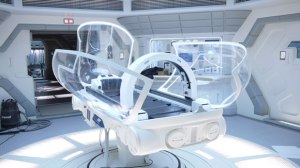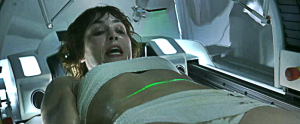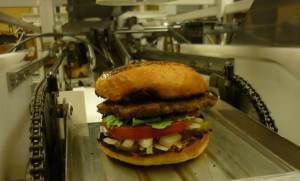In the blink of an eye, sci-fi dystopia becomes reality becomes the reality we take for granted becomes the legally enshrined status quo:
“One of our top priorities in Congress must be to promote the sharing of cyber threat data among the private sector and the federal government to defend against cyberattacks and encourage better coordination,” said Carper, ranking member of the Senate Homeland Security and Governmental Affairs Committee.
Of course, the pols are promising that data analyzed by the state will remain nameless:
The measure — known as the Cyber Threat Intelligence Sharing Act — would give companies legal liability protections when sharing cyber threat data with the DHS’s cyber info hub, known as the National Cybersecurity and Communications Integration Center (NCCIC). Companies would have to make “reasonable efforts” to remove personally identifiable information before sharing any data.
The bill also lays out a rubric for how the NCCIC can share that data with other federal agencies, requiring it to minimize identifying information and limiting government uses for the data. Transparency reports and a five-year sunset clause would attempt to ensure the program maintains its civil liberties protections and effectiveness.
Obama seems to suggest that third-party “cyber-info hubs”—some strange vivisection of private and public power—will be in charge of de-personalizing data in between Facebook and the NSA or DHS:
These industry organizations, known as Information Sharing and Analysis Organizations (ISAOs), don’t yet exist, and the White House’s legislative proposal was short on details. It left some wondering what exactly the administration was suggesting.
In the executive order coming Friday, the White House will clarify that it envisions ISAOs as membership organizations or single companies “that share information across a region or in response to a specific emerging cyber threat,” the administration said.
Already existing industry-specific cyber info hubs can qualify as ISAOs, but will be encouraged to adopt a set of voluntary security and privacy protocols that would apply to all such information-sharing centers. The executive order will direct DHS to create those protocols for all ISAOs.
These protocols will let companies “look at [an ISAO] and make judgments about whether those are good organizations and will be beneficial to them and also protect their information properly,” Daniel said.
In theory, separating powers or multiplying agencies accords with the vision of the men who wrote the Federalist Papers, the idea being to make power so diffuse that no individual, branch, or agency can do much harm on its own. However, as Yogi Berra said, “In theory there is no difference between theory and practice, but in practice there is.” Mark Zuckerberg and a few other CEOs know the difference, too. They decided not to attend Obama’s “cyber defense” summit in Silicon Valley last week.
The attacks on Target, Sony, and Home Depot (the attacks invoked by the state to prove the need for more state oversight) are criminal matters, to be sure, and since private companies can’t arrest people, the state will need to get involved somehow. But theft in the private sector is not a new thing. When a Target store is robbed, someone calls the police. No one suggests that every Target in the nation should have its own dedicated police officer monitoring the store 24/7. So why does the state need a massive data sharing program with the private sector? It’s the digital equivalent of putting police officers in every aisle of every Target store in the nation—which is likely the whole point.
Target, of course, does monitor every aisle in each of its stores 24/7. But this is a private, internal decision, and the information captured by closed circuit cameras is shared with the state only after a crime been committed. There is no room of men watching these tapes, no IT army paid to track Target movements on a massive scale, to determine who is a possible threat, to mark and file away even the smallest infraction on the chance that it is needed to make a case against someone at a later date.
What Obama and the DHS are suggesting is that the state should do exactly that: to enter every private digital space and erect its own closed circuit cameras, so that men in suits can monitor movement in these spaces whether a crime has been committed or not. (State agencies are already doing it, of course, but now the Obama Administration is attempting to increase the state’s reach and to enshrine the practice in law.)
“As long as you aren’t doing anything wrong, what do you care?”
In the short term, that’s a practical answer. In the future, however, a state-run system of closed circuit cameras watching digital space 24/7 may not always be used for justified criminal prosecution.
The next great technological revolution, in my view, will be the creation of an entirely new internet protocol suite that enables some semblance of truly “invisible” networking, or perhaps the widespread adoption of personal cloud computing. The idea will be to exit the glare of the watchers.






